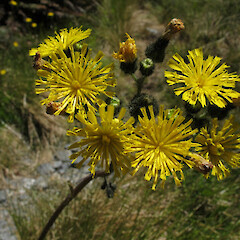Pilosella praealta
Common name
king devil
Synonyms
Pilosella piloselloides subsp. praealta (Gochnat) S. Bräut. & Greuter, Hieracium praealtum Gochnat
Family
Asteraceae
Flora category
Vascular – Exotic
Structural class
Herbs - Dicotyledonous composites
NVS code
The National Vegetation Survey (NVS) Databank is a physical archive and electronic databank containing records of over 94,000 vegetation survey plots - including data from over 19,000 permanent plots. NVS maintains a standard set of species code abbreviations that correspond to standard scientific plant names from the Ngä Tipu o Aotearoa - New Zealand Plants database.
HIEPRA
Conservation status
Not applicable
Habitat
Terrestrial. A plant of lowland, montane and subalpine habitats, grows in low fertility sites in shrubland, tussockland and riverbeds.
Wetland plant indicator status rating
Information derived from the revised national wetland plant list prepared to assist councils in delineating and monitoring wetlands (Clarkson et al., 2021 Manaaki Whenua – Landcare Research Contract Report LC3975 for Hawke’s Bay Regional Council). The national plant list categorises plants by the extent to which they are found in wetlands and not ‘drylands’. The indicator status ratings are OBL (obligate wetland), FACW (facultative wetland), FAC (facultative), FACU (facultative upland), and UPL (obligate upland). If you have suggestions for the Wetland Indicator Status Rating, please contact: [Enable JavaScript to view protected content]
UPL: Obligate Upland
Rarely is a hydrophyte, almost always in uplands (non-wetlands).
Detailed description
Perennial herb 15-45 cm tall, with stolons. Leaves 5-12 x 1-1.5 cm, entire, smooth bluish-green to red, leaf underside hairless except on mid-rib and edges. 3-35 yellow flower heads per stem.
Similar taxa
The presence of stolons, multiple yellow flowers and hairs confined to midrib and margins beneath the leaf distinguish this species from all other Hieracium in NZ.
Flowering
November, December, January, February, March
Flower colours
Yellow
Fruiting
(September) - November - March - (April)
Life cycle
Perennial. The plant reproduces vegetatively from stolons that give rise to 0-15 new rosettes (Timmins & MacKenzie 1995). Seed is prolifically produced with approximately 1 000/dm squared. Probably no seed bank is formed and seed is dispersed by wind (Timmins & MacKenzie 1995).
Year naturalised
1924
Origin
Europe
Reason for introduction
Accidental
Tolerances
Highly tolerant of drought and frost; tolerant of poor drainage and intolerant of shade. Also highly tolerant to physical damage but intolerant to grazing.
Etymology
pilosella: Softly hairy
National Pest Plant Accord species
This plant is listed in the 2020 National Pest Plant Accord. The National Pest Plant Accord (NPPA) is an agreement to prevent the sale and/or distribution of specified pest plants where either formal or casual horticultural trade is the most significant way of spreading the plant in New Zealand. For up to date information and an electronic copy of the 2020 Pest Plant Accord manual (including plant information and images) visit the MPI website.

